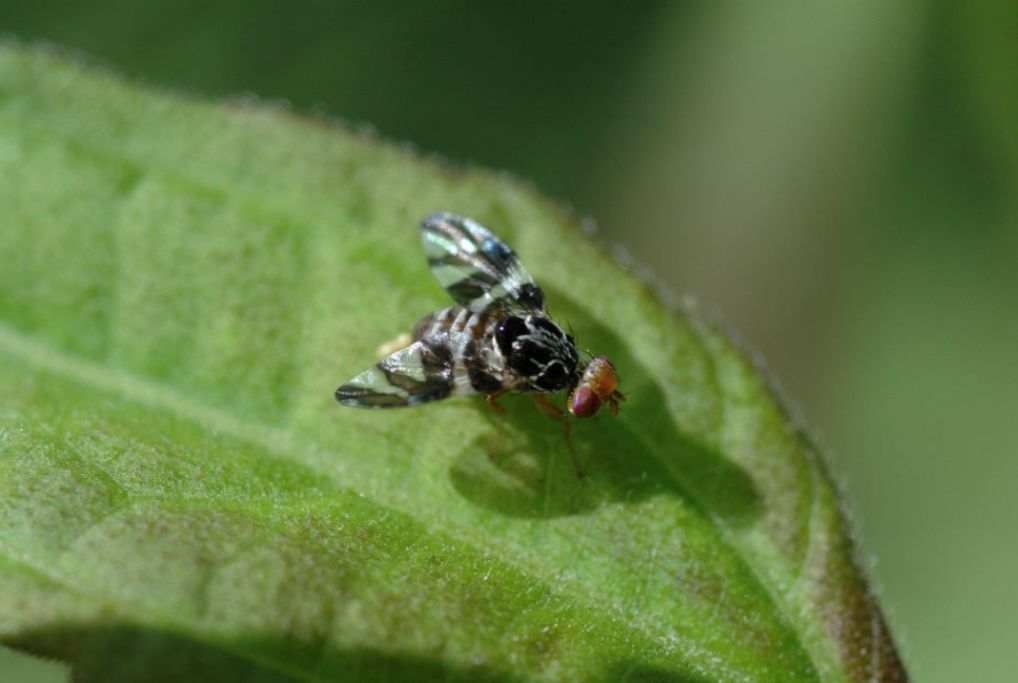ANZAC Gall Fly Release Promises Natural Solution To Weed Threat

A Kiwi-Australian collaboration with a difference is underway this ANZAC Day week on Bikini Atoll in the Marshall Islands.
New Zealand’s Manaaki Whenua – Landcare Research is collaborating with Biosecurity Queensland in Australia to release a gall fly to combat the spread of a serious invasive weed chromolaena (Chromolaena odorata).
The Chief of Quarantine in the Marshall Islands, Ms Silver Wase, says chromolaena was identified as a top priority for the Marshall Islands at a stakeholder workshop held in the country in December 2022.
“It was agreed then that natural enemies should be considered for use against the largest known infestation of chromolaena in the country which is on Bikini Atoll,” says Ms Wase.
Ms Lynley Hayes who leads Manaaki Whenua’s Pacific Natural Enemies – Natural Solutions (NENS) programme, says the chromolaena gall fly (Cecidochares connexa) is a highly effective natural enemy that combats chromolaena by stunting the growth, reducing flowering and stopping the plant from seeding. The fly attacks no other plants.
Mr Michael Day, Principal Entomologist (Honorary) Biosecurity Queensland is part way through his long journey - three flights, and an overnight boat trip – with a colony of gall flies in his carry-on. The flies have been bred by Biosecurity Queensland who released the fly in Australia in 2018 in its efforts to control the smothering plant. New Zealand is fortunate to be free of this weed.
The Bikini islanders were first relocated away from the Atoll in 1946 ahead of US nuclear testing, and then again in 1972 after the site was considered still dangerous, but the community is keen to eventually return home.
Meanwhile, without people present who can regularly attend to the chromolaena, which is regarded as one of the top 100 invasive species in the world, it has ample opportunity to spread across Bikini Atoll. A natural solution in the form of the gall fly was seen as the most practical way to bring the invasive species under control and prevent further spread to other islands and atolls.
“The chromolaena gall fly was first introduced into Indonesia in 1995 following extensive host specificity testing,” says Ms Hayes. “Since then, the fly is already making a difference in other parts of the Pacific after being introduced in Palau (1999), Papua New Guinea (2001), Guam (2002), Northern Marianas (2003), and the Federated States of Micronesia in 2004.”
Chromolaena is native to tropical America and found in many African, Asian and Pacific Island countries. It is a fast-growing perennial shrub that grows to about 2-3 metres producing large quantities of seeds that are easily dispersed by wind, or on machinery, people’s possessions, or animals.
The weed quickly outcompetes preferred grasses in grazing pastures, and affects the establishment of bananas, papaya and cocoa trees. Chromolaena is poisonous to cattle often causing fatal liver damage.
Using natural solutions for weed control is not unknown in the Marshall Islands. It is 70 years since a moth was released there to control the spread of lantana (Lantana camara).
Mr Day says Australia and New Zealand have been collaborating in the field of weed biological control even longer than that.
“Since the 1930s, both countries have consistently benefited from each other’s research. The real advantage is the savings that come from not having to reinvent the wheel in terms of the research, funding and testing of agents.”
While on Bikini Atoll, the team making the release will also be doing surveillance for other weeds and pests such as coconut rhinoceros beetle that pose a threat to the Marshall Island’s coconut plantations.
Manaaki Whenua’s NENS programme falls under the Pacific Regional Invasive Species Management Support Service (PRISMSS) which is supported by NZ’s Ministry for Foreign Affairs and Trade, and the GEF-6 Regional Invasives Programme. New Zealand and Australian researchers are collaborating to assist eight Pacific Island countries to combat a range of invasive weeds.
The GEF 6 RIP is funded by the Global Environment Facility, implemented by the United Nations Environment Programme, and executed by the Secretariat of the Pacific Regional Environment Programme. The project works primarily in the Marshall Islands, Niue, Tonga, and Tuvalu and has a regional component. The Pacific Regional Invasive Species Management Support Service supports implementation of the GEF6 RIP.


 The Reserve Bank of New Zealand: CoFR Seeking Feedback On Access To Basic Transaction Accounts
The Reserve Bank of New Zealand: CoFR Seeking Feedback On Access To Basic Transaction Accounts 2Degrees: Stop The Pings - Half Of Kiwis Overwhelmed By Notifications
2Degrees: Stop The Pings - Half Of Kiwis Overwhelmed By Notifications Electricity Networks Association: How Many More Trees Need To Fall On Power Lines Before The Rules Change?
Electricity Networks Association: How Many More Trees Need To Fall On Power Lines Before The Rules Change? Parrot Analytics: Netflix Earnings - Price Hikes With Minimal Churn | Will Netflix Be A Bright Spot For Markets?
Parrot Analytics: Netflix Earnings - Price Hikes With Minimal Churn | Will Netflix Be A Bright Spot For Markets? Canterbury Museum: Mystery Molars Lead To Discovery Of Giant Crayfish In Ancient Aotearoa New Zealand
Canterbury Museum: Mystery Molars Lead To Discovery Of Giant Crayfish In Ancient Aotearoa New Zealand Ngā Pae o te Māramatanga: Māori Concerns About Misuse Of Facial Recognition Technology Highlighted In Science
Ngā Pae o te Māramatanga: Māori Concerns About Misuse Of Facial Recognition Technology Highlighted In Science



